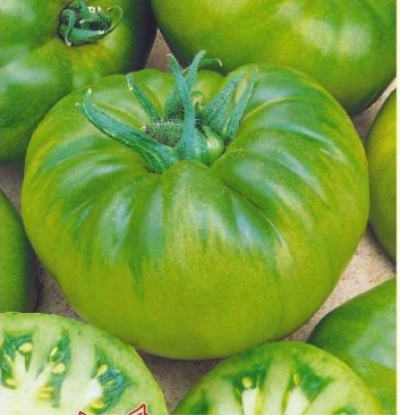
- Authors: Fotev Yu. V., Kotelnikova M. A., Kondakov S. N. (Agrofirma "Altai Seeds" LLC)
- Year of approval: 2010
- Category: grade
- Growth type: determinant
- Appointment: fresh consumption, for whole fruit preservation
- Ripening period: mid-season
- Ripening time, days: 113-126
- Growing conditions: for open ground, for film greenhouses, for greenhouses
- Marketability: high
- Transportability: high
The name of the tomato Emerald standard can charm many gardeners and gardeners. But only those of them who study the features of this culture closely will be able to achieve complete success in cultivation. It is important to familiarize yourself with both the planting scheme and other features of cultivation, with taste and with the level of fertility, with the main measures of care.
Breeding history
Work on the Emerald Shtambov was carried out at the agricultural firm "Seeds of Altai". The management of the LLC entrusted such a project to breeders Fotev, Kotelnikova and Kondakov. The plant obtained thanks to their efforts was successfully registered in 2010.
Description of the variety
The emerald standard tomato is characterized by a determinate developmental nature. It can be used both for open gardens and for greenhouse farms of various kinds. The height of the bushes ranges from 0.6 to 0.8 m. The dark green foliage is small. For a plant, as the name implies, the formation of boles is typical.
The main qualities of the fruit
The very first berries to form will have a normal green color. A dark green spot will be created near the stem. Fully ripe tomatoes will acquire an emerald color corresponding to the variety name. Other basic parameters:
the average weight is 110 g;
in shape, the fruit resembles a flattened circle;
ribs are relatively poorly developed;
berries grow from simple type inflorescences;
guaranteed shelf life is 3 or 4 months, depending on storage conditions.
Taste characteristics
Emerald standard tomato leaves a sweet-fruity taste. In this regard, it is capable of challenging many popular members of the nightshade family. The sugary pulp reaches a moderate density.
Ripening and fruiting
Emerald standard tomato is a typical mid-season tomato. Between the appearance of the earliest green shoots and the time of harvest, 113 to 126 days pass. It will be possible to harvest until the end of the growing season - the main thing is that it has time to ripen.
Yield
In such a culture, berry picking per 1 sq. m reaches 5.5 sq. m. Although this figure is not a record, but still the harvest is practically guaranteed. Its stability will delight farmers who want to get rid of overly complex worries.
The timing of planting seedlings and planting in the ground
It makes sense to sow seeds in containers during March. Until the required readiness is achieved, the seedlings develop from 60 to 65 days. In this case, it is necessary to take into account the readiness of specific plants for transplantation.

Growing tomato seedlings is an extremely important process, because it largely depends on whether the gardener can harvest at all. All aspects must be taken into account, from seedbed preparation to planting in the ground.
Landing scheme
For this variety, it is recommended to place previously strengthened bushes according to the 500x400 mm system. There is no point in considering other options.

Growing and care
It is a pleasure to look after the Emerald standard. It does not need to be pinned or tied up. But without the formation of bushes, the matter is still not complete. In the open field, it is advised to leave 1 or 2 stems. Using 3 or even 4 stems is advisable in greenhouse planting. The variety is quite resistant to infection by fungal diseases, which, however, does not give any reason for complacency and refusal of protective treatments.
Although the plant is said to withstand adverse weather conditions, greenhouses are strongly advised in areas with difficult climates. Watering with warm water should be carried out systematically. The soil is loosened periodically when it becomes excessively dense. Weeds are removed as soon as they appear, preventing them from developing. It is advisable to use mineral fertilizers based on potassium and phosphorus.
Seedlings are grown in the same way as seedlings of red varieties. Adult plants need to be fed 2 or 3 times during the growing season. Even if carefully tested seeds are used, they should be disinfected. Mulching a tomato is highly desirable. Landings only benefit from pinching.




A plant needs different micronutrients at each stage of growth. All fertilizers can be divided into two groups: mineral and organic. Folk remedies are often used: iodine, yeast, bird droppings, eggshells.
It is important to observe the rate and period of feeding. This also applies to folk remedies and organic fertilizers.



























































































